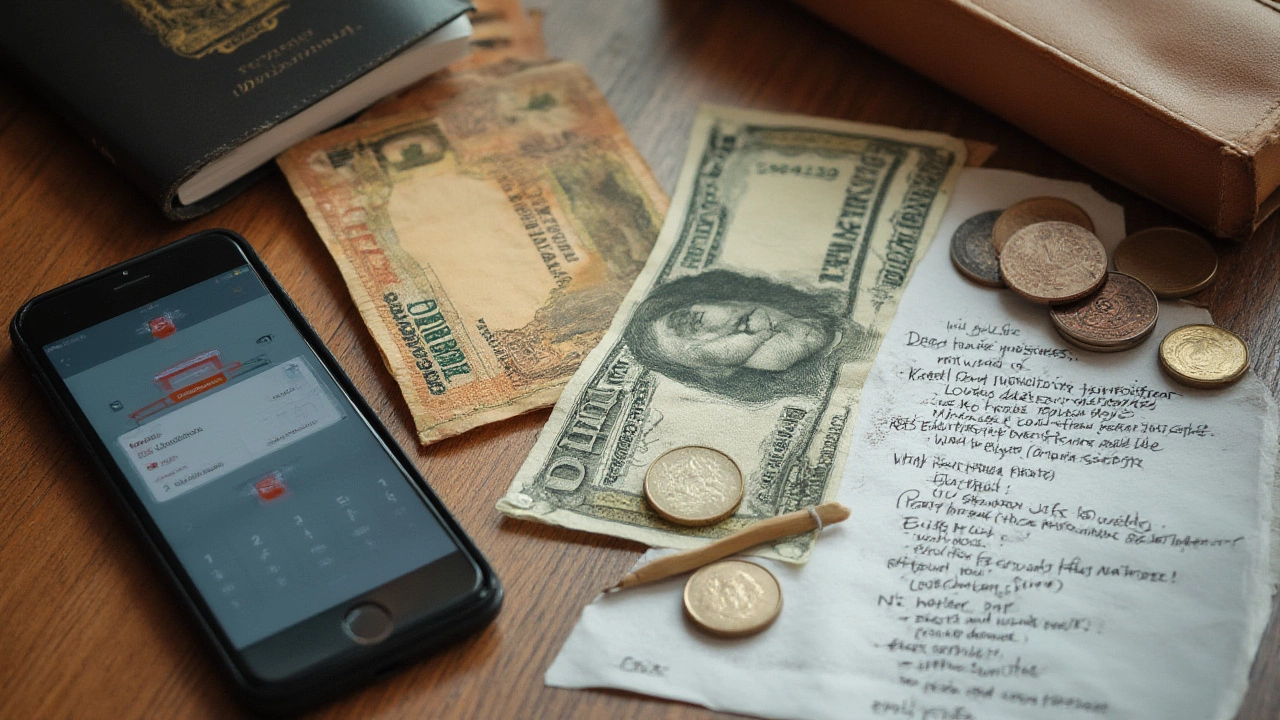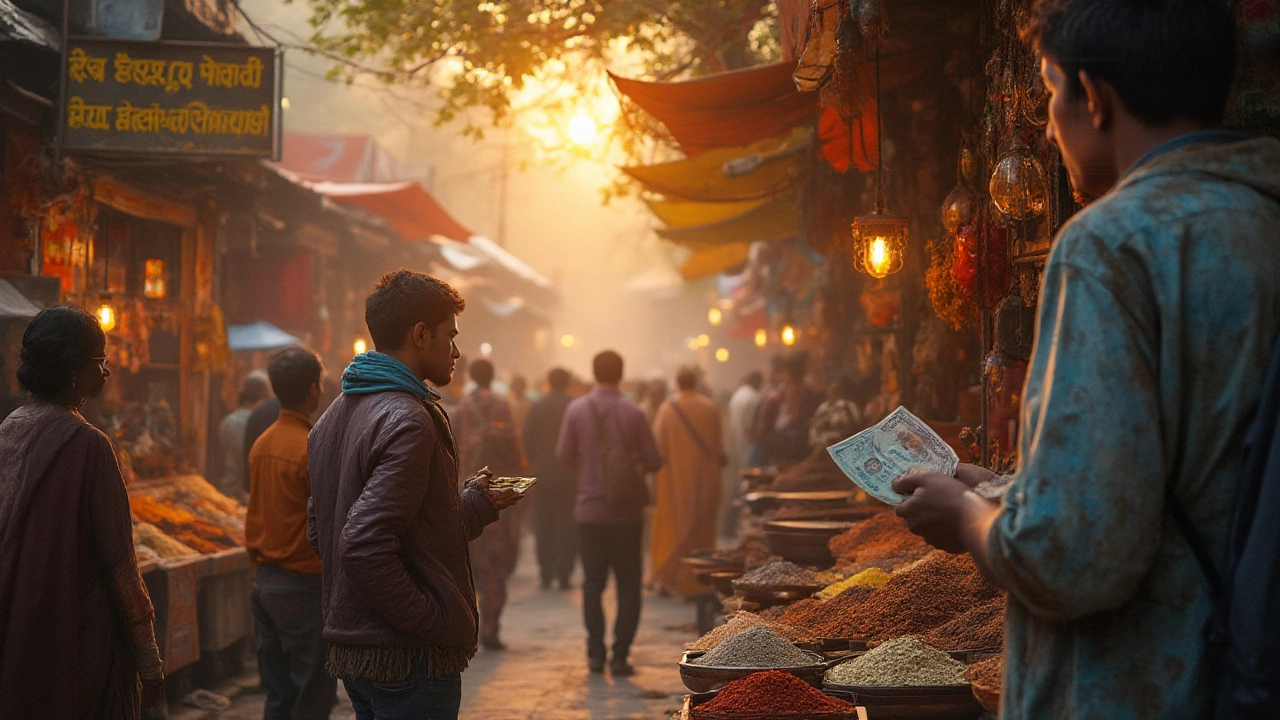You ever wonder how far a single US dollar can stretch on the bustling streets of Mumbai? Or maybe you picture yourself counting out rupees for a chai in a lively Delhi market. Here's the thing—knowing the US dollar to INR exchange rate in 2025 isn’t simply about math. It shapes everything from shopping, food habits, and hotel choices to the way you plan your next adventure in India. Let's crack open the facts, controversy, and travel know-how behind trading your dollars for rupees today.
Current Exchange Rate: What Does $1 Mean in India Right Now?
First, let’s carve out the numbers that matter. As of July 13, 2025, the official exchange rate for 1 US dollar hovers around 85.6 Indian Rupees (INR). Of course, this isn’t pulled out of thin air—it reflects the exchange market, global politics, oil prices, inflation, and a bit of unpredictable economic magic. If you look up the past few years, the dollar has gradually gained ground against the rupee. Five years ago, $1 got you about 75 INR. Now it's 85.6 INR. That means, if you’re coming from the States, your money goes a bit further in India than it used to. For residents in India shopping online or traveling abroad, it stings a little extra.
Here’s a quick look at the USD to INR trend:
| Year | USD to INR Rate |
|---|---|
| 2021 | 74.2 |
| 2022 | 76.8 |
| 2023 | 81.1 |
| 2024 | 83.5 |
| 2025 | 85.6 |
But hold on, there’s more to the story than just numbers. The rate you see online isn’t always the one you get at a local currency exchange or ATM. Most currency shops, banks, and airport kiosks will have buy/sell spreads. That means you might receive 83 to 85 INR per dollar, instead of 85.6. ATMs may charge a transaction fee or bake a margin into their rate. If you bring in USD cash bills, you’ll find the best rates for clean, newer notes. Torn or old bills? Expect to lose 1–2 rupees per dollar, if the shop even accepts them at all.
For people living in major Indian cities—Delhi, Mumbai, Bangalore, Hyderabad—ATMs are everywhere. But in smaller towns or the Himalayas, card payment and currency exchange options shrink fast. It’s smart to stock up before heading off-the-grid. Oh, and travelers sometimes get better rates at authorized forex shops downtown than at airport counters. Airports are convenient but often pricier.

Spending Power: What Buys You Across India
This is where it gets fun and a little wild. India is famous for stretching your dollar further than you thought possible. Let’s break it down. With 85 rupees in your hand today, you’ve got enough for a steaming plate of street-side samosas (about 30 INR each), a hot chai (20 INR in a glass cup), and still enough left for a tuk-tuk ride down the block. If you stray from the big cities into smaller towns, you’ll find prices even lower—sometimes by half.
| Item | Average Cost (INR) | How Many for $1? |
|---|---|---|
| Chai (street stall) | 20 | 4 cups |
| Samosa | 30 | 2-3 pieces |
| Local bus fare (city) | 15 | 5-6 rides |
| 1-liter bottled water | 20 | 4 bottles |
| Budget hostel bunk (per night) | 500 | 0.17 nights |
| Mid-range restaurant meal (main dish) | 300 | 0.28 meals |
If you lean into the local lifestyle—travel by bus, eat at roadside dhabas, and haggle in the markets—you can make each dollar work wonders. On the flip side, if you prefer air-conditioned cafes, taxis, and Western chains, you’ll burn through rupees as quickly as you would dollars back home.
Here are some tips to maximize your spending power:
- Find cheap eating spots—look for busy stalls with locals, especially in the mornings for snacks and tea.
- Ride rickshaws or use metro trains for city hopping; taxis are much pricier, especially app-based ones in tourist neighborhoods.
- Shop for fresh produce at street markets instead of supermarkets—prices are often half.
- Remember that in tourist hotspots like Agra or Jaipur, everything costs more: keep an eye on price lists and ask locals for typical rates before paying.
If you’re planning a bigger trip, hotel prices swing wildly. In metros, business hotels and chic boutique stays might run 4000–8000 INR ($47–$93) per night. Hostels with Wi-Fi and breakfast can be found for less than 900 INR ($10.50) in most backpacker centers. South India, especially Kerala’s beach towns or the temple cities like Madurai, is known for being a touch cheaper than the north.
And don’t forget, if you’re feeling particularly thrifty, try staying in an ashram or dharamshala—many run by religious trusts accept donations instead of fixed prices. It’s a different vibe but a real travel experience.

Exchanging Money: Tricks, Traps, and Traveler Success Stories
No one wants to fumble their first rupee note, or worse, lose money without realizing it. Here’s where smart, prepared travelers can save more. First up—the airport trap. Sure, it’s convenient to grab cash the second you land, but the rate is almost always 1 to 3 INR worse than the city banks or reputable forex offices downtown. If you need instant cash, only change a small amount at arrival. Wait till you reach your hotel or the main city areas to exchange the bulk.
Indian banks, like State Bank of India or ICICI, often offer competitive rates, but they want to see your passport and sometimes even flight details. Many hotels, especially in touristy spots, will also change money, but expect rates 2–5% worse than official banks. Some ATMs are “international-friendly” (try HDFC, Axis Bank, or SBI), but your US or global bank may levy $2–$5 per withdrawal, plus 1–3% currency conversion fees. Call your bank before you leave, and consider applying for a no-foreign-transaction-fee card if you travel often.
When it comes to physical bills, many Indian money changers love crisp, recent USD notes—preferably the blue-security-stripe newer versions. Torn, marked, or old-style (pre-2006) notes are regularly rejected, or valued lower. This seems petty, but it’s true. So check your bills before you pack.
Watch for fake currency, especially if swapping cash on the street. Stick to big brands (like Thomas Cook), major banks, or authorized Forex offices. Indian rupees come in notes ranging from 10 all the way up to 2000, but the 2000s are being phased out—they can be hard to break. Most locals love 10, 20, 50, 100, and 500 rupee bills. Coins are still in wide circulation: 1, 2, 5, and 10 INR coins are very common for snacks, rickshaw fares, and change.
- Always count your cash before you leave the counter, whether it’s rupees or dollars.
- If you’re unsure of the math, whip out your phone. Most shops have calculator apps already open for you.
- If you’re exchanging large sums, ask for a written receipt and count every note, making sure none are torn or heavily marked.
As of 2025, travel cards (prepaid FX cards) have become a big hit for US/Europe-based tourists: you preload your funds and swipe as you go in India. These cards let you lock in the current exchange rate before your trip, dodge ATM fees, and avoid carrying fat stacks of cash. Some brands, like Wise or Revolut, update rates in real-time and let you freeze your card instantly if lost or stolen. A few government-backed rupee cards are even being tested for tourists, but most travelers still stick with global names.
Every year, new scams pop up. Fake ATM overlays, unofficial money exchange touts, and dodgy payment apps aren’t just horror stories. Stick to known big-name chains and city stores. If you’re using payment apps like Google Pay or Paytm, remember: funding from a US or non-Indian bank card is complicated. You’ll likely need an international travel card or cash for small daily expenses.
Keep a mix of payment options—cards, cash, and at least one backup plan. Many stores in big cities now accept international credit and debit cards via chip readers. But in rural areas and on trains, cash remains king. Always have a reserve of smaller notes for emergencies, especially after sundown or during festival rushes when ATMs go dry.
Let’s say you have $100. Converted at the current USD to INR rate (using a realistic exchange counter, say 85 to the dollar), that’s 8,500 rupees. That’s enough to eat in cheap restaurants for a week, visit a couple of national monuments (entry for foreigners is higher—think 500 to 1000 INR), and ride every metro line in a city for days.
But if you’re the type to indulge in rooftop bars, five-star buffets, or flights between Jaipur and Kochi, $100 disappears fast. Big ticket attractions like the Taj Mahal (entry fee for foreigners: 1200 INR in 2025) devour your rupees much quicker than a trip to see ancient temples in Tamil Nadu (entry: 50–200 INR max).
Last tip? Download a live currency converter app before boarding your flight, so you always know the USD to INR rate, and can call out that sly uncle who tries to overcharge you for trinkets in the market.
